What constitutes a ‘document’ and how does it function?
According to the Oxford English Dictionary, the etymological origin is the Latin ‘documentum’, meaning ‘lesson, proof, instance, specimen’. As a verb, it is ‘to prove or support (something) by documentary evidence’, and ‘to provide with documents’. The online version of the OED includes a draft addition, whereby a document (as a noun) is ‘a collection of data in digital form that is considered a single item and typically has a unique filename by which it can be stored, retrieved, or transmitted (as a file, a spreadsheet, or a graphic)’. The current use of the noun ‘document’ is defined as ‘something written, inscribed, etc., which furnishes evidence or information upon any subject, as a manuscript, title-deed, tomb-stone, coin, picture, etc.’ (emphasis added).
Both ‘something’ and that first ‘etc.’ leave ample room for discussion. A document doubts whether it functions as something unique, or as something reproducible. A passport is a document, but a flyer equally so. Moreover, there is a circular reasoning: to document is ‘to provide with documents’. Defining (the functioning of) a document most likely involves ideas of communication, information, evidence, inscriptions, and implies notions of objectivity and neutrality – but the document is neither reducible to one of them, nor is it equal to their sum. It is hard to pinpoint it, as it disperses into and is affected by other fields: it is intrinsically tied to the history of media and to important currents in literature, photography and art; it is linked to epistemic and power structures. However ubiquitous it is, as an often tangible thing in our environment, and as a concept, a document deranges.
the-documents.org continuously gathers documents and provides them with a short textual description, explanation,
or digression, written by multiple authors. In Paper Knowledge, Lisa Gitelman paraphrases ‘documentalist’ Suzanne Briet, stating that ‘an antelope running wild would not be a document, but an antelope taken into a zoo would be one, presumably because it would then be framed – or reframed – as an example, specimen, or instance’. The gathered files are all documents – if they weren’t before publication, they now are. That is what the-documents.org, irreversibly, does. It is a zoo turning an antelope into an ‘antelope’.
As you made your way through the collection,
the-documents.org tracked the entries you viewed.
It documented your path through the website.
As such, the time spent on the-documents.org turned
into this – a new document.
This document was compiled by ____ on 06.10.2023 08:39, printed on ____ and contains 15 documents on _ pages.
(https://the-documents.org/log/06-10-2023-5454/)
the-documents.org is a project created and edited by De Cleene De Cleene; design & development by atelier Haegeman Temmerman.
the-documents.org has been online since 23.05.2021.
- De Cleene De Cleene is Michiel De Cleene and Arnout De Cleene. Together they form a research group that focusses on novel ways of approaching the everyday, by artistic means and from a cultural and critical perspective.
www.decleenedecleene.be / info@decleenedecleene.be - This project was made possible with the support of the Flemish Government and KASK & Conservatorium, the school of arts of HOGENT and Howest. It is part of the research project Documenting Objects, financed by the HOGENT Arts Research Fund.
- Briet, S. Qu’est-ce que la documentation? Paris: Edit, 1951.
- Gitelman, L. Paper Knowledge. Toward a Media History of Documents.
Durham/ London: Duke University Press, 2014. - Oxford English Dictionary Online. Accessed on 13.05.2021.

My dream hollyday We were a football
on the beach
We were a modern house.
We were a We swim in the swimming
pool.
June 2022, Marche-en-Famenne. I arrived half an hour early. Waiting for my family to pick me up at the station, near a linden tree, I found a yellow page lying on the pebbles in front of the wooden bench I sat on. It had been a hot day. The sun was finally setting. Music playing in the distance. A white Volkswagen. Windows closed. Hard basses, trembling across the road. Folded three times, the sheet of paper had the size of a DIN A7. A white BMW pulled over. Seven glass jars in a container.
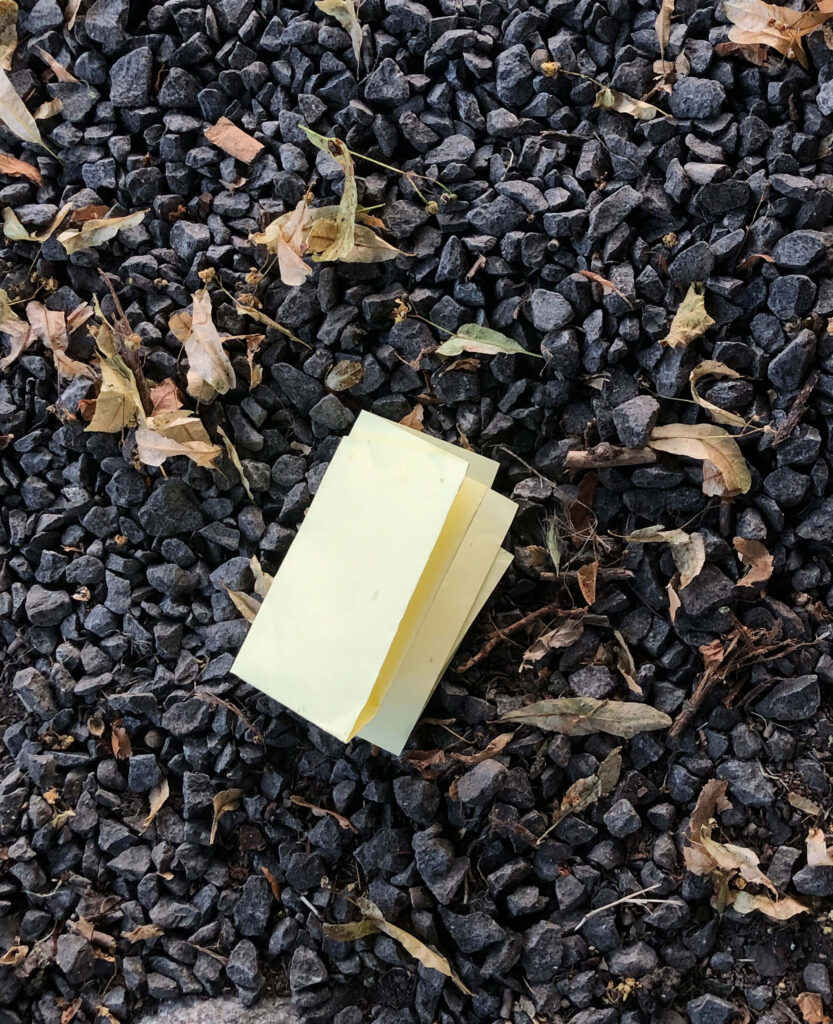
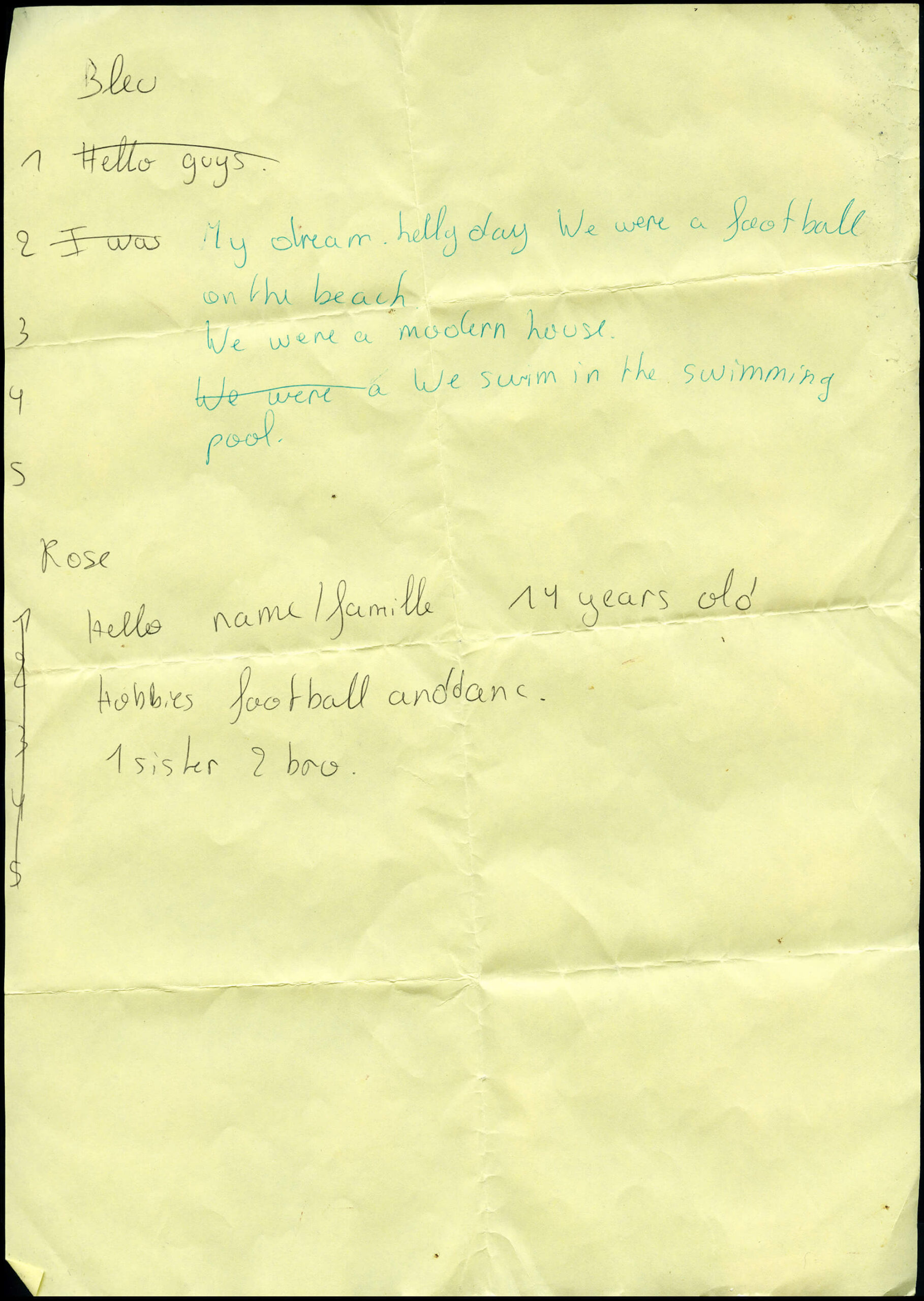
In 2020, the print versions of the Flemish telephone books ‘Gouden Gids’ and ‘Witte Gids’ (The Golden Guide and The White Guide), were published for the last time. From that year onwards, the directory could only be accessed and consulted online. The effect of the production of print telephone directories on the environment is considered to be enormous. As yearly updated, ubiquitous books, they were publications that soon turned superfluous. They led to piles of waste.
From the beginning of the 21st century on, both the print version and the online version had been available. This was a period of medium transition. During the last two decades, the print directory increasingly referred to the websites of the companies listed. To search for e.g. someone to inspect the heating installation, it was possible to find such a company’s website via the print directory, and consult the inspector’s services and price online, bypassing search engines such as Google and its complex algorithms. The telephone directory had a thematic and alphabetical order, combined with the possibility to buy additional advertising space.
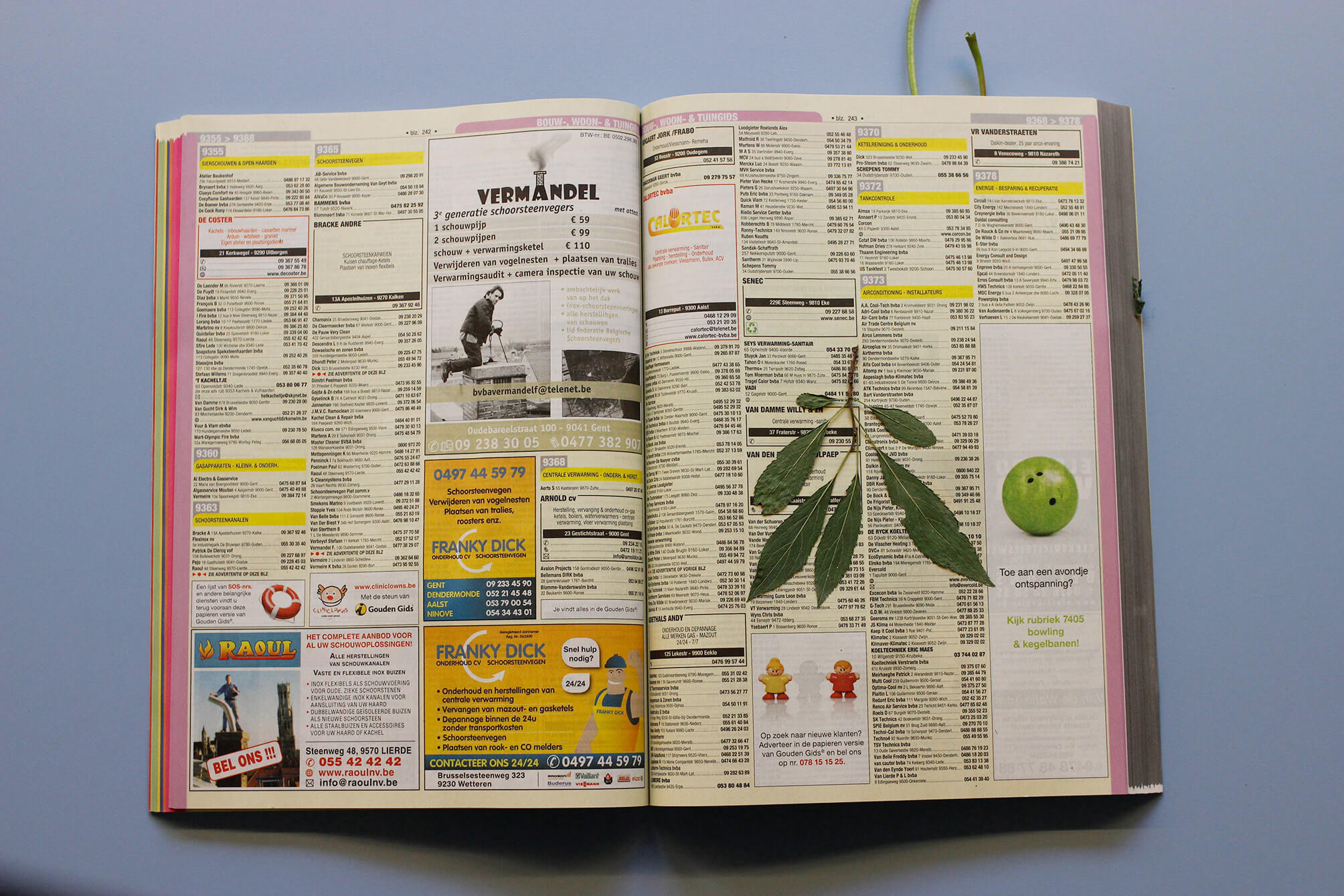
The scientific exactitude sought for in the Iconographie de la Salpêtrière and the Nouvelle Iconographie de la Salpêtrière, the (in)famous scientific publications stemming from Paris’ psychiatric hospital La Salpêtrière (1876-1918), lead to an abundance of photographic images in their pages. The photographs’ ideal: ‘Trace incontestable, incontestablement fidèle, durable, transmissible’.1 The ambition of exactitude results in cold, and often cruel depictions of patients. In the digitized version of the Sorbonne library’s copies, some photographs have left an imprint on the opposite page. The knee of Charles, ‘le géant’, adds an unwanted layer upon its measures on the opposite page, while the photograph of the knee itself loses ink.2
Didi-Huberman, G. Invention de l’hystérie. Paris: Macula, 2014, 72.
Launois, P.-E., Roy, P., ‘Gigantisme et infantilisme’, Nouvelle Iconographie de la Salpêtrière, Tome XV, 1902, 548, pl. LXVI, online: https://patrimoine.sorbonne-universite.fr/fonds/item/2613-nouvelle-iconographie-de-la-salpetriere-tome-15?offset=6

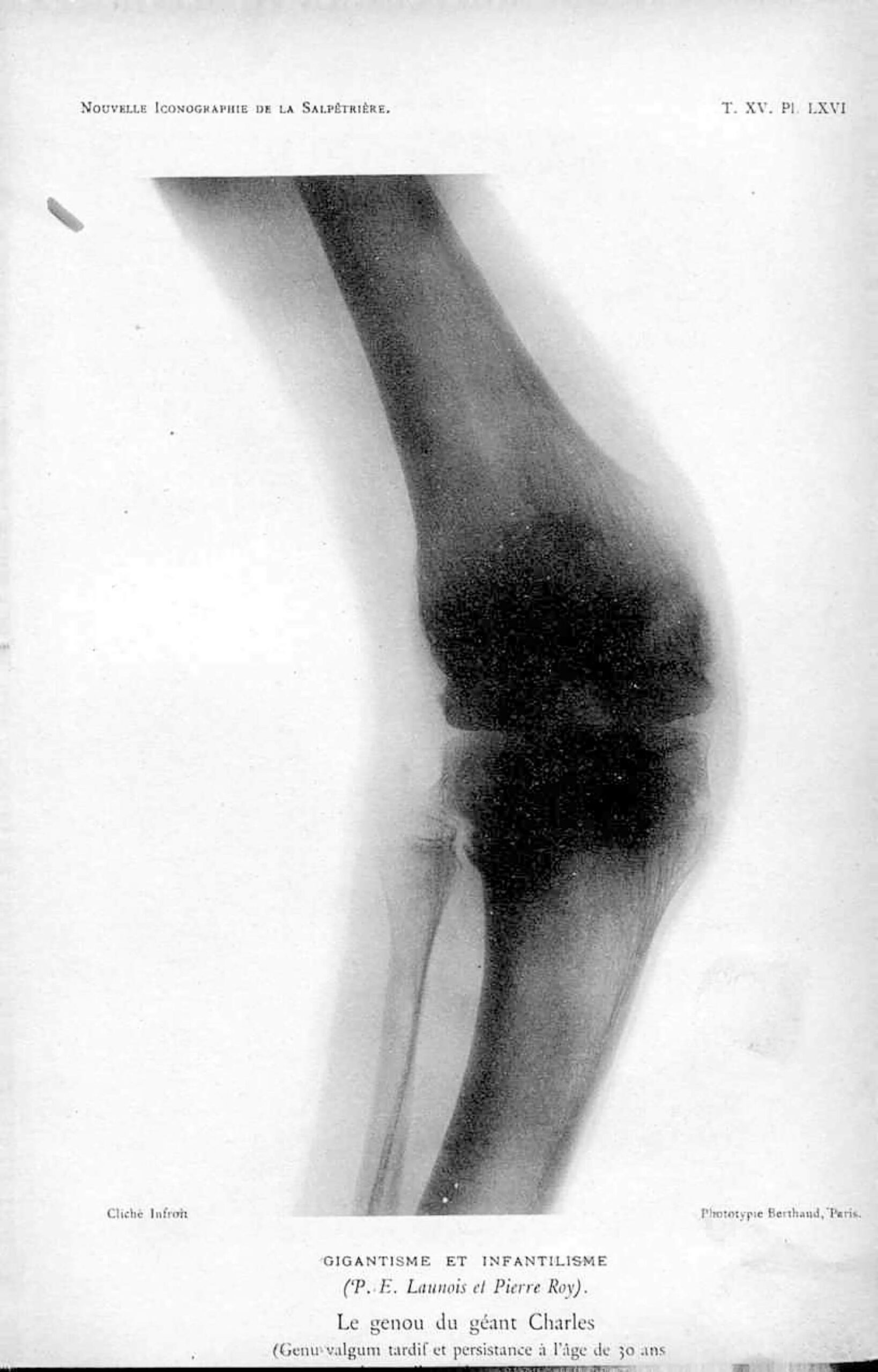
Ten years ago, in November, I drove up to Frisia – the northernmost province of The Netherlands. I was there to document the remains of air watchtowers: a network of 276 towers that were built in the fifties and sixties to warn the troops and population of possible aerial danger coming from the Soviet Union. It was very windy. The camera shook heavily. The poplars surrounding the concrete tower leaned heavily to one side.
I drove up to the seaside, a few kilometers farther. The wind was still strong when I reached the grassy dike that overlooked the kite-filled beach. I exposed the last piece of film left on the roll. Strong gusts of wind blew landwards.
Months later I didn’t bother to blow off the dust that had settled on the film before scanning it. A photograph without use, with low resolution, made for the sake of the archive’s completeness.
The dust on the film appears to be carried landwards, by the same gust of wind lifting the kites.
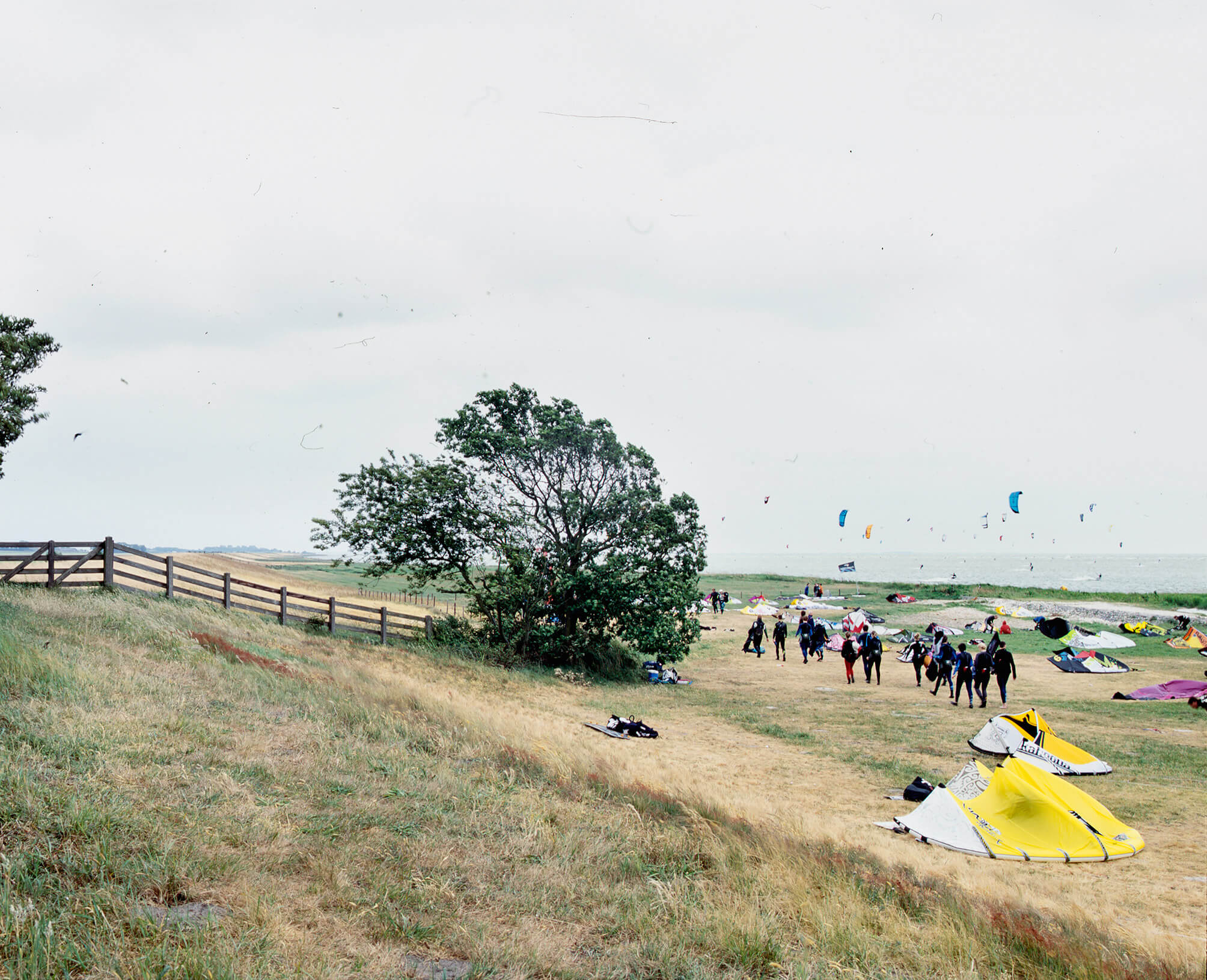
Coming back from holidays, we were waiting for the ferry to take us from Ramsgate to Ostend. We were well on time. As the ship entered the harbour, I asked my parents if I could take a photograph. It’s the first photograph I recall taking. I remember my dad telling me to wait long enough for the ship to get closer. I didn’t. I only got one try.1
It took a while before the film was developed. I couldn’t stop imagining what the photograph would look like: some picturesque waves in the foreground, the shining white ship, the red and blue text on the side, and a cloud filled sky.
Following every holiday, when we got home, the garden and our house would be photographed with the remaining exposures on the roll of film in the camera.
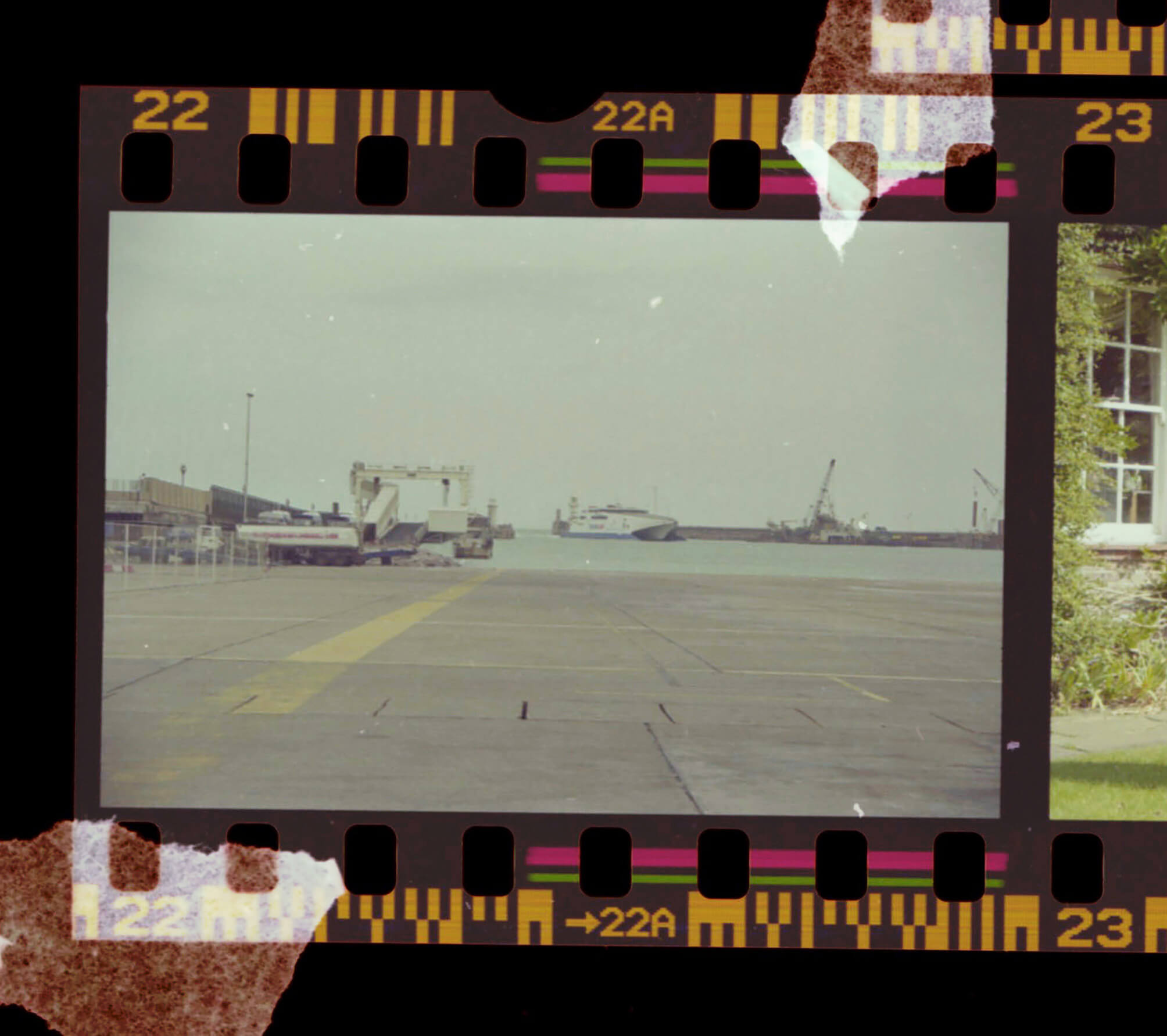
The weeds and bushes on what over the years has become savanna are being chopped to clear the ground to replant trees and reinstate the forest. During the dry season, forest fires are frequent. In between the future lots of planted trees, firebreaks are made to keep fires from spreading. Wires are used to measure the required distance between plant beds and to keep a straight line. The sun is sinking. In a bit, the workers will return home and the field will empty out. In a couple of years, the Acacias, Ebben trees, Millettia laurentii and Umbrella trees will testify to the strings.
https://www.fajalobi.org
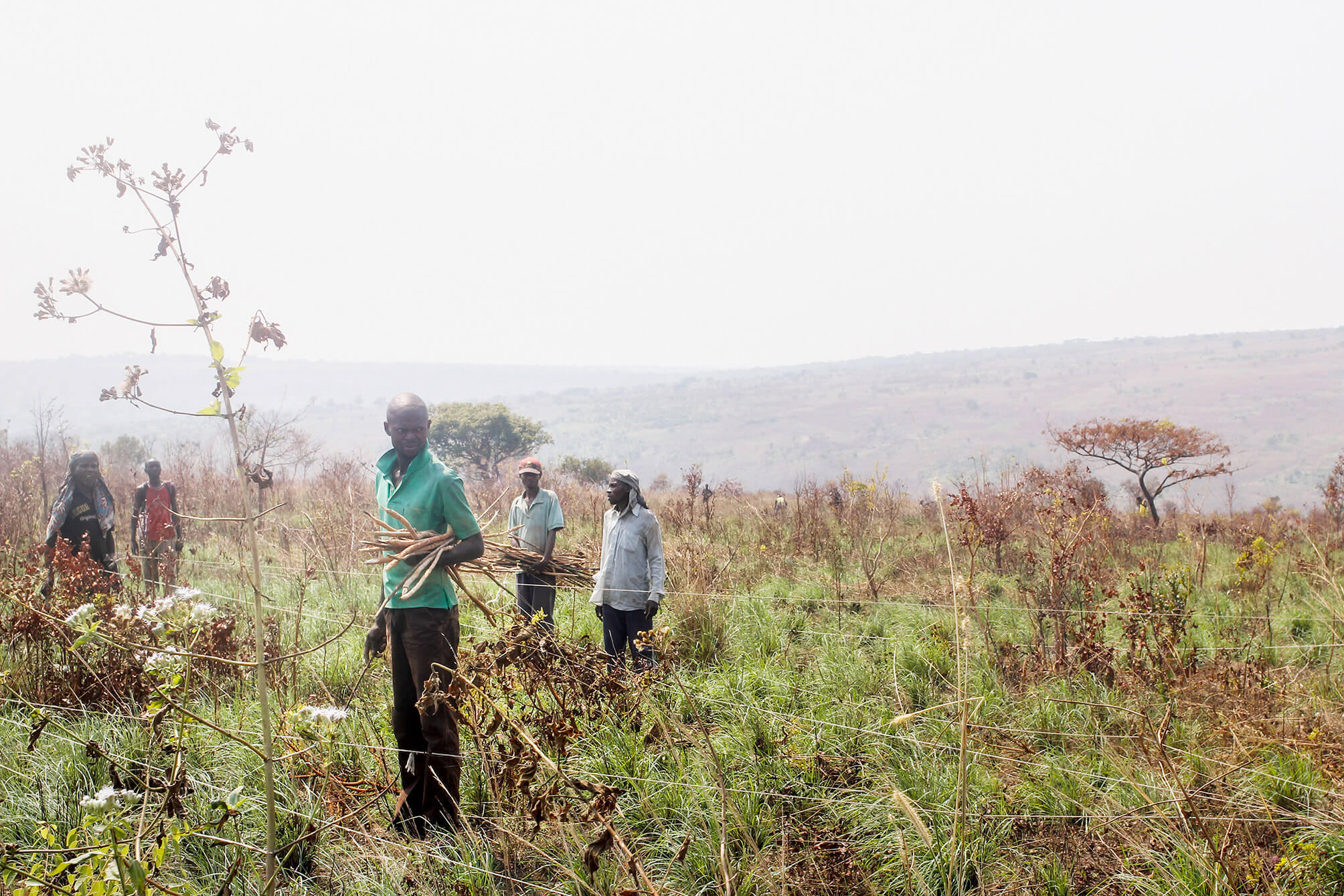
In between two cities along the Belgian coast, water has run from the dunes (and the Second World War Heritage site scattered among them), underneath the coastal road and tram rails, to the beach. It has formed a small S-shaped estuary, bound to disappear due to the increasingly harsh wind coming from the coast of Britain, blowing North-easterly, and hammering down on the levee. The vibrations of the empty Ostend-bound tram passing just before the photograph was taken, had no visible impact on the estuary.

Ten years ago, in November, I drove up to Frisia – the northernmost province of The Netherlands. I was there to document the remains of air watchtowers: a network of 276 towers that were built in the fifties and sixties to warn the troops and population of possible aerial danger coming from the Soviet Union. It was very windy. The camera shook heavily. The poplars surrounding the concrete tower leaned heavily to one side.
I drove up to the seaside, a few kilometers farther. The wind was still strong when I reached the grassy dike that overlooked the kite-filled beach. I exposed the last piece of film left on the roll. Strong gusts of wind blew landwards.
Months later I didn’t bother to blow off the dust that had settled on the film before scanning it. A photograph without use, with low resolution, made for the sake of the archive’s completeness.
The dust on the film appears to be carried landwards, by the same gust of wind lifting the kites.

A Sunday stroll near my parents’ house. Along one of the roads between the fields, old poplars have been felled. Young trees have been planted. Each one has a baby blue coloured label, identifying them as Poplar tree, and, more specifically, the ‘Vesten’ cultivar. This cultivar is planted since it is one of the cultivars known for its resistance with regards to bacteria, diseases and insects. The tags on the trunks have staples keeping them together. They’re like bracelets. Come spring, the expanding diameter of the fast growing poplar species’ trunk will tear them apart.
Steenackers, M., Schamp, K., & De Clercq, W. (2018). De INBO variëteiten van populier, een aanwinst voor de Europese populierenteelt. Silva belgica : tijdschrift van de koninklijke belgische bosbouwmaatschappij = bulletin de la société royale forestière de belgique, N°4/2018, 40-47. [5].
https://purews.inbo.be/ws/portalfiles/portal/15044340/Dossier_populier_INBO_KBBM.pdf

‘The saw cuts are sloppy and appear to be made in a haste.1 The cuts are situated at a height of approximately seventy centimetres from the ground. The hill’s protected woods have seen an increase in these scattered traces of illegal logging since a rise in tax on heating fuel in October 2012. Many Greeks set about logging illegally in protected woods, mostly in the colder North of the country, but also here in Egaleo, a western suburb of Athens.’
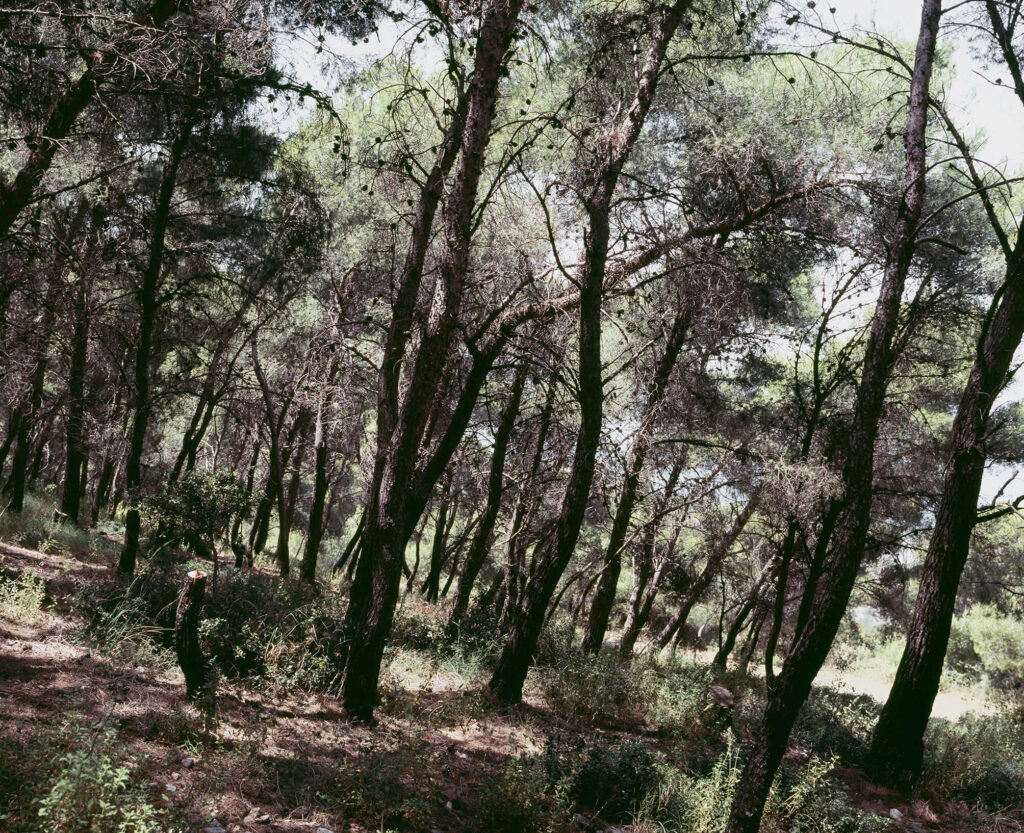
First published in: De Cleene, M. Reference Guide. Amsterdam: Roma Publications, 2019
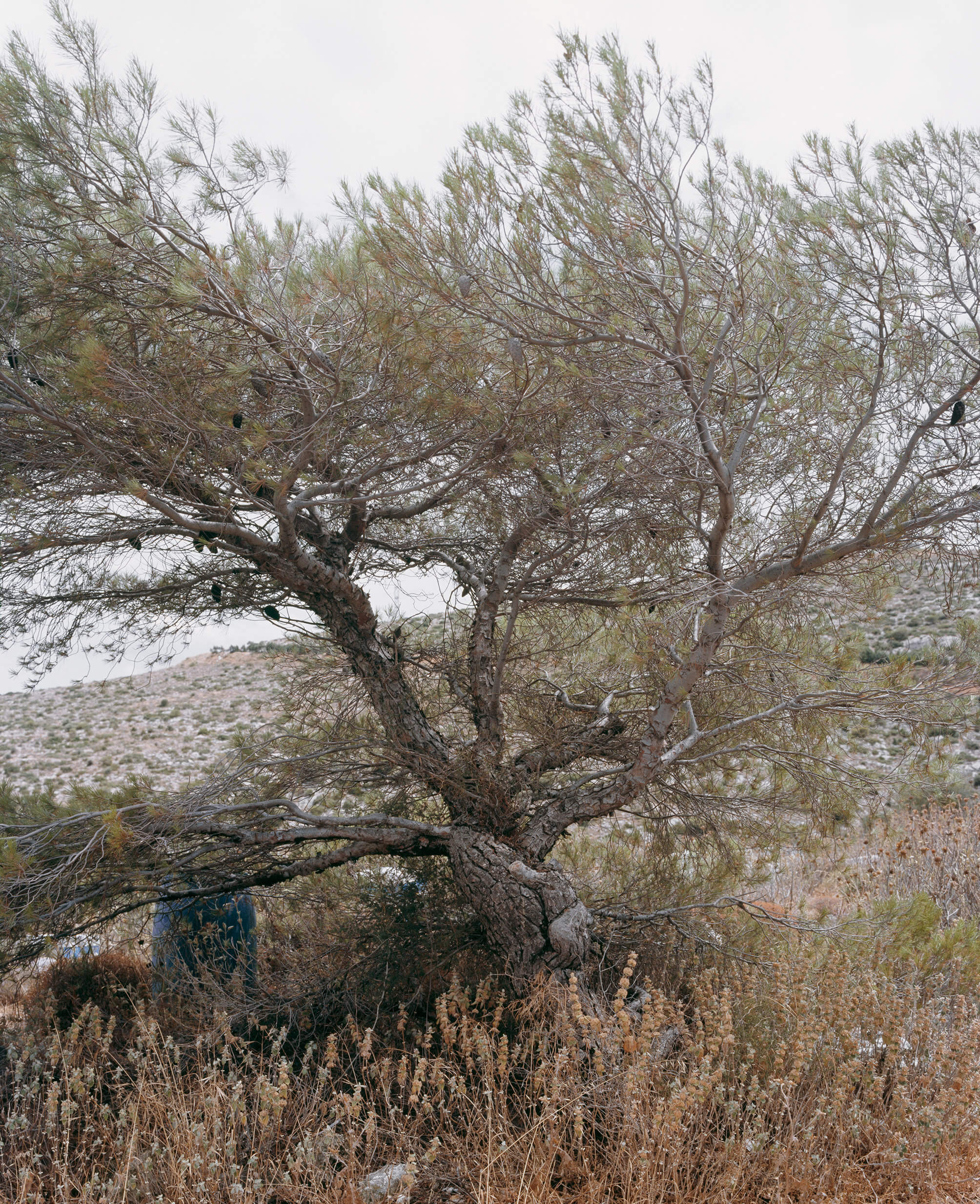
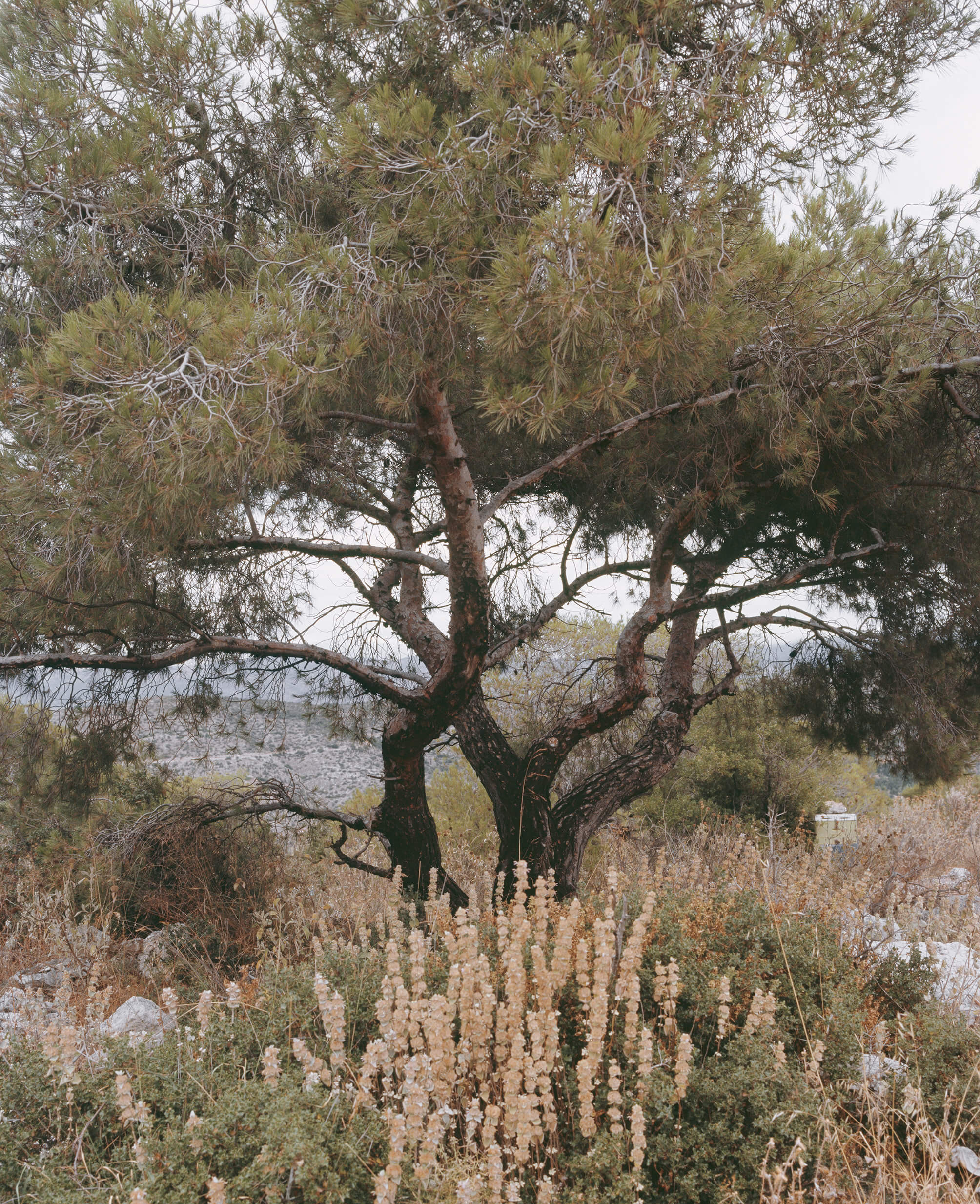
Seven very similar and rudimentary buildings take in a trapezoid plot of land in Gilly. They are located between the school on the Rue Circulaire and the houses along the Rue de l’Abbaye. The structures are built of orange brick, concrete structural elements, whitish steel gates and roofing. Every garage has its own number, hand-painted in white on the concrete lintel above each gate. In summer the roofing gets hot and soft.
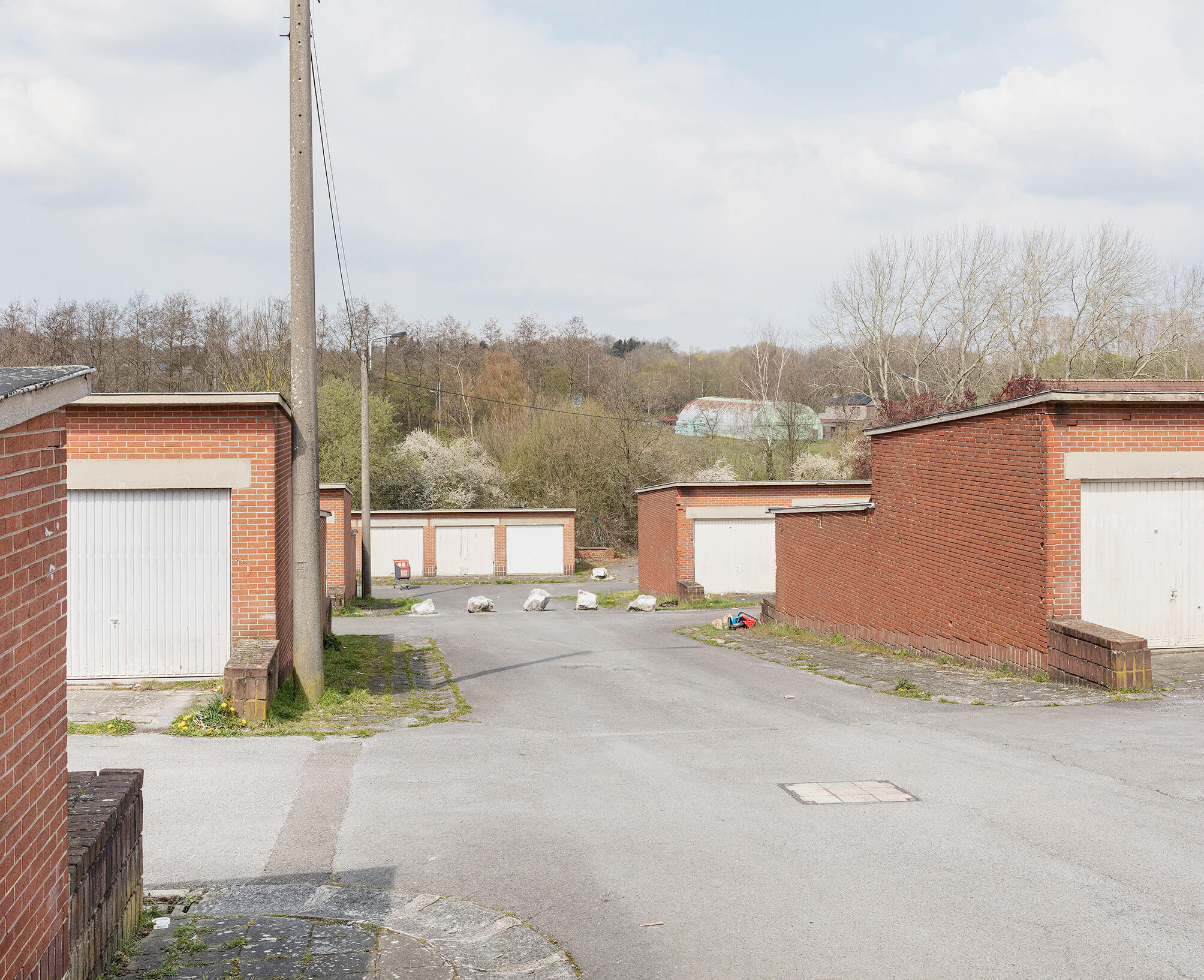
Five white boulders close off a shortcut for motorists who attempt to cut the bend in the road. The southernmost roof’s pitch runs opposite to the landscape’s slope. The lower roofline is, therefore, only about one meter above a small, triangular patch of grass which is hidden from view by a hedge. In summer, when the roofing gets hot and soft, text and drawings get pressed or carved into it.
Google Earth
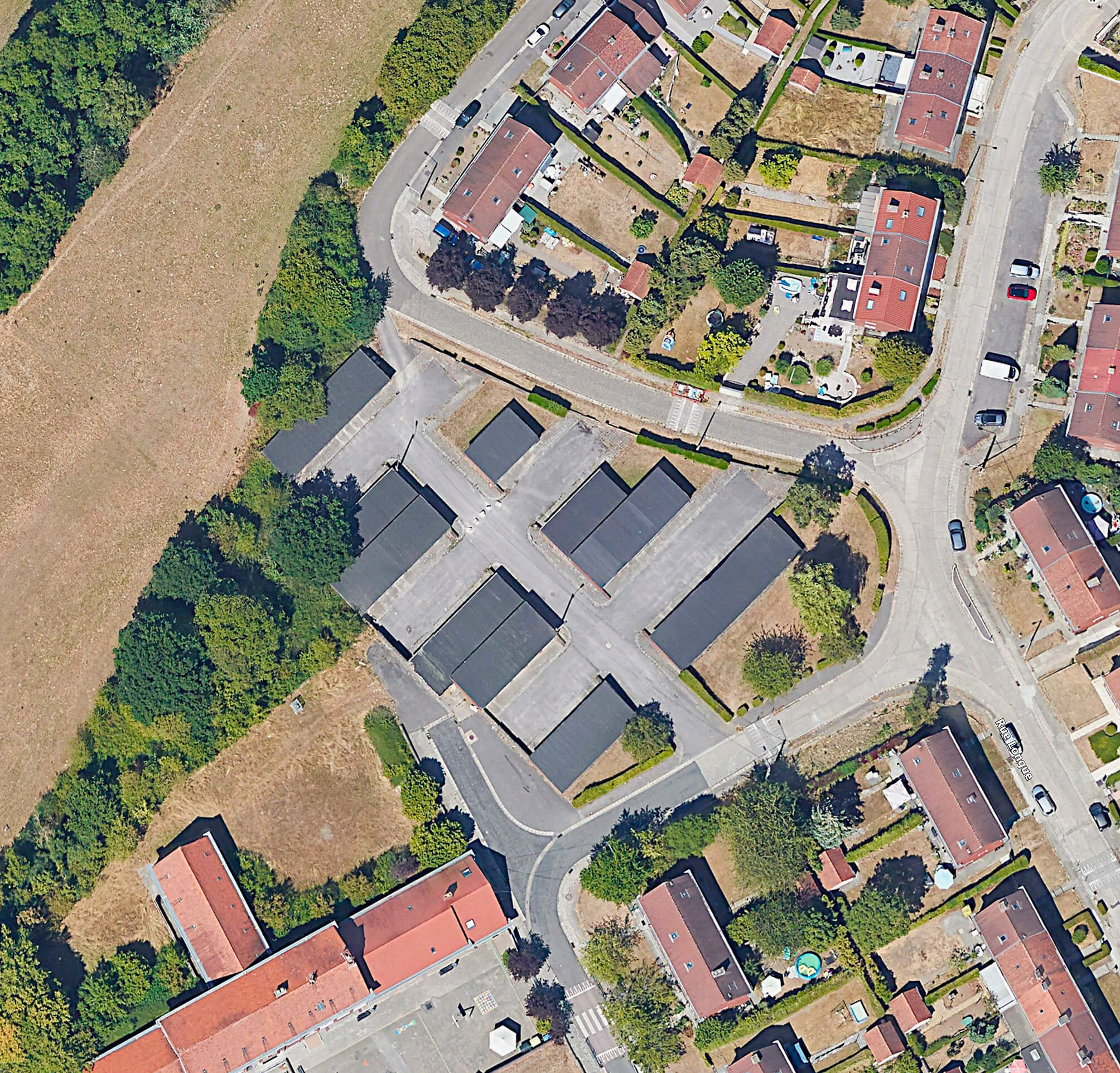
In what order and by whom the various texts and drawings were carved into the soft roofing is unclear. To the right of ‘EVA’, a heart symbol and an arrow (pointing to the left), the roofing reads ‘SIMON TU ME MANQUES’.
The short sentence usually – yet hastily – translates to ‘Simon, I miss you’. However, in French the ‘you’ (tu) is the subject and has an active role, whereas the ‘I’ (me) is the direct object. In short: by his not being there, Simon actively effectuates hurt to the one who carved this text.
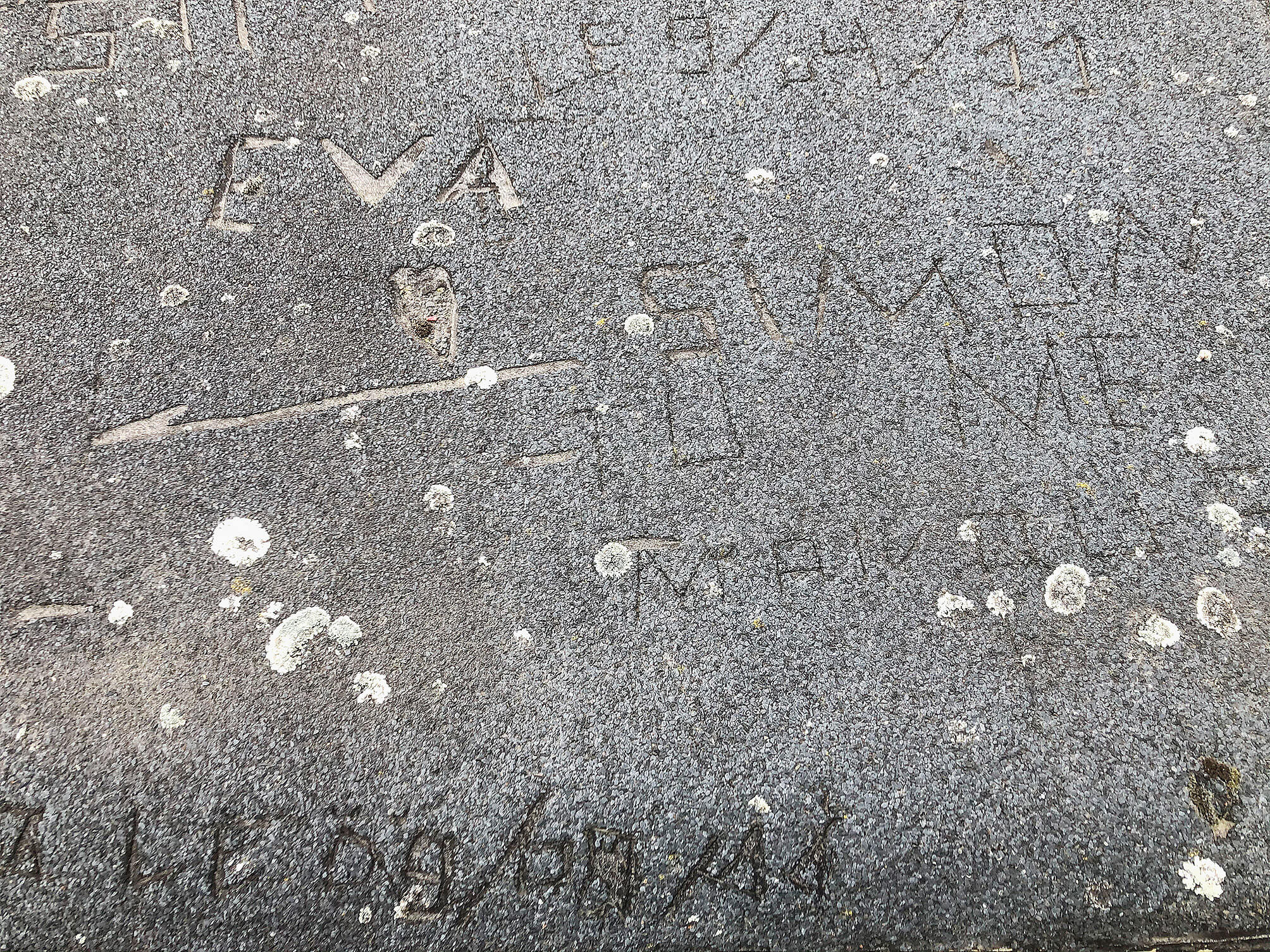
The two photographs arrived in Belgium inside a used hardback1 in spring 2016, though it is unclear how long before that time they were actually taken.2
Photograph #1 measures 151 x 100 mm and shows two young people who appear to be mountain climbing and captured while clearing a ridge. Behind the two subjects a bluish mountainous landscape is vaguely visible, suggesting a vantage point of some considerable elevation. The person on the left is wearing a white T-shirt and a bracelet, and has several earrings. The person on the right is carrying a backpack. What appears to be a black tank-top may in fact also be the straps of the pack. On their head they wear what appears to be a grey T-shirt or other garment, presumably to protect the subject from the sun; this person also has earrings and is wearing a necklace and sunglasses. The weather appears nice, both subjects are smiling and appear relaxed. The effort may well have been staged.
Photograph #2 measures (approximately) 43 x 62 mm with the left, bottom and right sides appearing to be cut, rather unevenly, with scissors. It has the typical appearance of an American high school yearbook photo and shows a young person wearing a shiny black blouse and a necklace. They have blue eyes and below-shoulder length auburn hair. The red lips appear painted. On the back of this photograph is written in a clearly legible hand:
Clay, I can’t
wait until next
year when we’re
in grade 12!3
Have a great
Summer and
call me [XXX XXXX]4
by the way, I haven’t
forgot about how big UR
The only assumptions to be made somewhat safely from these two items are that (a) the book has once belonged to ‘Clay’, and, (b) a relationship of a close, friendly, perhaps even intimate, nature has at one time existed between ‘Clay’ and the person in the second photograph (assuming also that (c) the note on the back of the second photograph was indeed written by the person in that photograph). The circumstances surrounding, and/or motivations (‘Clay’’s or any third parties’) behind the book’s ending up in a used-book shop5 must necessarily remain a matter of speculation. There are no reasons to assume that the book was gifted to ‘Clay’ by the note-writer (or by anyone else) as no dedication appears in it.6 It must also remain inconclusive whether there are either two or three different persons appearing across the two photographs, and whether any of these is in fact ‘Clay’.
Indeed, the number of questions raised by these items far exceeds the number of answers they provide. Even leaving aside the nature of the writings in the book, one cannot help but speculate as to:
— how much, if any, of the book ‘Clay’ ever read;7,8
— what happened to the CD originally included with the book;9
— why the unrelated inserted materials were not removed from the book before sale (as opposed to the CD);
— whether ‘Clay’ did in fact ring up the writer of the note over that summer;10 indeed whether the two ever did meet again, remain close during their ‘senior’ year, perhaps even stay in contact after graduating;
— the meaning of the rather cryptic final line of the note.
The book is a first edition, first printing hardback copy of Word Virus: the William S. Burroughs reader, edited by James Grauerholz and Ira Silverberg, with an introduction by Ann Douglas, published by Grove Press (New York) in 1998 (160mm x 235mm, 532pp.). On the used book aggregator webstore, the book was graded ‘Very Good’ (or, VG),* which proved a realistic assessment as it appeared (in fact, still does) largely unread with a dust jacket in equally good condition and no markings inside whatsoever. In fact, the book’s condition might well have warranted a ‘Fine’ (F) grading were it not for the only notable (yet not noted) defect, which was that the ‘Spoken Word CD’ that was originally included — as indicated by a 32mm diameter round sticker in the top right corner of the front of the dust jacket, and the glued-in envelope in the back of the book — was no longer present. This defect may well have accounted for the apparent disparity between the state and grading of the book and the low price of $4.53 (shipping not included) it was sold at, although the fact remains that this incomplete state ought to have been mentioned in the listing. Since the time of purchase, however, markings were added to the book, presumably with an additional adverse effect on its market value: appearing on the half-title page, they are in dark green crayon and of an abstract nature and were made by the current owner’s infant son.
* According to the terminology of the grading scale proposed in 1949 by AB Bookman’s Weekly and still widely, if not universally, in use in the online used book market today, albeit with some additions or modifications by individual platforms. See Wikipedia for a brief overview.
Elements of style and physical nature of the artifacts may be taken to indicate an origin roughly contemporaneous with the book.
‘[In the United States of America, the] twelfth grade is the twelfth school year after kindergarten. It is also the last year of compulsory secondary education, or high school. Students are often 17–19 years old. Twelfth graders are referred to as Seniors.’ (Wikipedia)
A 7-digit phone number, without country or area code, redacted here.
Located in the state of Nevada, no further identification of the particular shop was provided on the aggregator webstore, and it must be noted that the book was subsequently shipped from ‘Auburn’, presumably Auburn, CA.
Indeed in accordance with its ‘Very Good’ grading, which is generally understood to explicitly list any defects such as markings (including dedications) but also any missing materials.
Quality hardbacks being notably easier to read without damaging the book.
Speculations on this, and any potential subsequent extrapolations are, fortunately perhaps, further inhibited by the fact that the book presents a rather generous cross-section of writings spanning the entirety of William S. Burroughs’ famously prolific career. The inclusions span the period between 1929 and 1994. Although undertakings of this kind will inevitably meet with criticism, the consensus indeed seems to be that the editors have done an excellent job in selecting and presenting the material. Was ‘Clay’ mainly drawn by the hard-boiled straightforward prose style of the early novels; the highly experimental and provocative writings of the ‘middle period’ (traditionally labeled as rather ‘hermetic’ and ‘cold’, though they are quite often not without a haunting, perhaps even ‘poetic’ quality); or the later, one might say ‘integrated’ style which saw the earlier experiments wedded to a certain ‘return to narrative’ and, in old age, traces of a much more ‘humane’ author than ever before (if a point of critique may yet be formulated, one might indeed say that the writings from this later period (roughly 1978–1997) are somewhat favoured (quantitatively) in the Word Virus volume; as these have a (still: relatively) greater ‘readability’ than much of the older material that may indicate a decision of a commercial nature, yet there is also the fact that these texts were written in collaboration with one of the editors of Word Virus)?
Being in fact a promo sampler for the 4CD Giorno Poetry Systems compilation of William S. Burroughs material also released (by Mouth Almighty Records and Mercury Records) in 1998. See Discogs.
Nevada has three area codes (702, 725, and 775), yet quick Google searches of the 7-digit number combined with any one of those yield no easy identification. Considering the overall scarcity of information, however, it seems clear that anyone seeking to reconstruct the biographies of ‘Clay’ and/or the note-writer should take up this line of investigation.
David Depestel hesitates in trying to make something of himself; a character, a profession, a fixed mode of being, are for him concepts that already shadow forth the outlines of the skeleton, which is all that will be left of him in the end.
https://en.wikipedia.org/wiki/List_of_used_book_conditions
https://en.wikipedia.org/wiki/Twelfth_grade#United_States
https://www.discogs.com/release/673857-William-S-Burroughs-Selections-From-The-Best-Of-William-Burroughs-From-Giorno-Poetry-Systems


_44A6588.dng
At 13:26:43 I took a photograph of a concrete building without windows in an industrial zone just south of Brussels.
_44A6590.dng
At 16:46:15 I photographed a succession of office buildings in the same industrial zone.
_44A6589.dng
I must have walked about 1 kilometer between the concrete building without windows and the section of the industrial zone with the offices. At 13:43:49, the camera, safely stored in my backpack, recorded 0.4 seconds of the 20 minutes it took me to get there.
In The Snows of Venice, Alexander Kluge wonders whether he can take the liberty to conjure up what the sky looked like on 31 December 1799, as Schiller made his way to Goethe’s house. He goes on by saying that, historically, there’s a ‘LACK OF SENSORY ATTENTION AT CRUCIAL MOMENTS’.1 There are exceptions, though, like the cameraman that was sent out to document the fireworks on New Year’s Day 2000. The camera was turned on prematurely. The batteries were used up by midnight, but ‘certain gray tones, however, filtered through the cracks of its protective case, conveyed the motion of the walking cameraman, the transportation. The incompletely shut, low-information container was documented exactly […] To this day it provides inexact testimony as to the qualities of the leather of a twenty-first century carrying case and the precise sensitivity to light and dark demonstrated by a twenty-first century recording medium.’2
Lerner, B., Kluge, A. The Snows of Venice. Leipzig: Spector Books, 2018, p. 53
Ibid.
